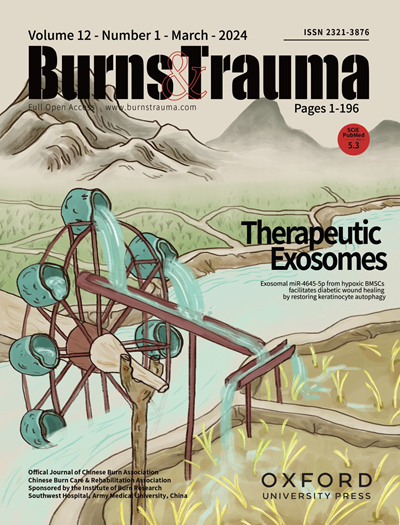Role of damage-associated molecular patterns (DAMPs) in the pathogenesis and therapeutics of traumatic brain injury
IF 9.6
1区 医学
Q1 DERMATOLOGY
引用次数: 0
Abstract
Traumatic brain injury (TBI) is a serious condition that poses a significant threat to human health globally. It is typically caused by direct trauma to the brain due to external forces such as impact or compression. The progression of TBI occurs in two stages based on physiological and pathological changes: primary and secondary brain injury. During the secondary stage, a large number of damage-associated molecular patterns (DAMPs) are released from injured cells into the extracellular space. These DAMPs trigger or exacerbate pathological conditions, including neuroinflammation, brain edema, diffuse axonal injury (DAI), and programmed cell death. The three main types of neural cells—neurons, microglia, and astrocytes—facilitate intercellular communication and functional crosstalk through the release and transmission of DAMPs. This forms the cellular foundation of secondary brain injury pathology. In the later stages of TBI, DAMPs are transported to various organs throughout the body via extracellular vesicles (EVs), leading to systemic changes and secondary injuries. Recent research has increasingly recognized the correlation between TBI and specific DAMPs. However, there remains a lack of comprehensive reviews exploring this relationship from a broader perspective. This review summarizes the primary pathological changes that occur after TBI, the types of DAMPs and their related signaling pathways, the role of DAMPs in mediating intercellular communication and neuronal crosstalk, the relationship between DAMPs and systemic changes following TBI. This study also highlights that DAMPs represent promising targets for the clinical diagnosis and treatment, which emphasizes the critical role of DAMPs in TBI.损伤相关分子模式(DAMPs)在创伤性脑损伤发病机制和治疗中的作用
外伤性脑损伤(TBI)是一种严重的疾病,对全球人类健康构成重大威胁。它通常是由外力如冲击或压迫对大脑造成的直接创伤引起的。基于生理和病理变化,TBI的进展可分为两个阶段:原发性和继发性脑损伤。在第二阶段,大量损伤相关分子模式(DAMPs)从损伤细胞释放到细胞外空间。这些阻尼触发或加剧病理状况,包括神经炎症、脑水肿、弥漫性轴索损伤(DAI)和程序性细胞死亡。三种主要类型的神经细胞——神经元、小胶质细胞和星形胶质细胞——通过释放和传递DAMPs促进细胞间通讯和功能串扰。这构成了继发性脑损伤病理的细胞基础。在TBI的晚期,DAMPs通过细胞外囊泡(EVs)转运到全身各个器官,导致全身改变和继发性损伤。最近的研究越来越多地认识到TBI与特异性DAMPs之间的相关性。然而,仍然缺乏从更广泛的角度探讨这种关系的全面综述。本文综述了脑外伤后发生的主要病理改变、DAMPs的类型及其相关信号通路、DAMPs在介导细胞间通讯和神经元串扰中的作用、DAMPs与脑外伤后全身变化的关系。本研究还强调了DAMPs是临床诊断和治疗的有希望的靶点,这强调了DAMPs在TBI中的关键作用。
本文章由计算机程序翻译,如有差异,请以英文原文为准。
求助全文
约1分钟内获得全文
求助全文
来源期刊

Burns & Trauma
医学-皮肤病学
CiteScore
8.40
自引率
9.40%
发文量
186
审稿时长
6 weeks
期刊介绍:
The first open access journal in the field of burns and trauma injury in the Asia-Pacific region, Burns & Trauma publishes the latest developments in basic, clinical and translational research in the field. With a special focus on prevention, clinical treatment and basic research, the journal welcomes submissions in various aspects of biomaterials, tissue engineering, stem cells, critical care, immunobiology, skin transplantation, and the prevention and regeneration of burns and trauma injuries. With an expert Editorial Board and a team of dedicated scientific editors, the journal enjoys a large readership and is supported by Southwest Hospital, which covers authors'' article processing charges.
 求助内容:
求助内容: 应助结果提醒方式:
应助结果提醒方式:


